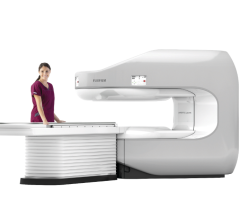
May 29, 2019 — A clinical study presented at the American Thoracic Society (ATS) 2019 annual meeting, May 17-22 in Dallas, described the use of Konica Minolta’s Dynamic Digital Radiography (DDR) technology in the assessment of undifferentiated dyspnea.
Forty-three patients were enrolled in an Institutional Review Board (IRB)-approved study at Mount Sinai St. Luke’s in New York that compared the results of DDR with chest X-ray (CXR), computed tomography (CT) and pulmonary function testing (PFT). Lead investigator Mary M. O’Sullivan, M.D., associate professor at the Icahn School of Medicine Mount Sinai, will share a visual case series to demonstrate how DDR may potentially assist both the pulmonologist and the radiologist to more clearly identify newly recognized pathophysiologic abnormalities and better understand the context of the underlying disease.
“Dyspnea, or shortness of breath, is a common complaint with different underlying causes that can make it difficult to pinpoint the patient’s condition,” explained O’Sullivan. “It involves complex pathological processes that may be the result of lung disease or heart disease, as well as abnormalities of the musculoskeletal system, neurological disease and body habitus. Additionally, for the first time, in DDR, the functionality of quiet respiration (tidal breathing) is explored. This is of great importance because tidal breathing is the type of breathing that the patient does during most of their daily life. Current studies, such as CXR, CT scan and PFT, are performed in a forced breath maneuver and this can underestimate how much pulmonary reserve the patient actually has. By enabling direct visualization of the kinesiology of the respiratory system, DDR may allow for earlier discovery and a more clear understanding of the etiology of dyspnea in a patient, enabling the clinician to streamline tests and reduce the time from evaluation to diagnosis.”
In 2017, the Icahn School of Medicine at Mount Sinai and Konica Minolta Healthcare partnered to study the impact of DDR in the assessment of dyspnea and pulmonary diseases, including asthma and chronic obstructive pulmonary disease (COPD). Clinicians from the departments of pulmonology and radiology have been evaluating the use of DDR across different pulmonary disease types. At the ATS 2018 annual meeting, a clinical study by Mount Sinai concluded that DDR may be a clinically relevant option to assess COPD severity in the acute setting and for patients unable to perform PFTs. At the 2018 annual meeting of the Radiological Society of North America (RSNA), Alexander Somwaru, M.D., assistant professor of radiology at the Icahn School of Medicine at Mount Sinai, and Alexander Kagen, M.D., site chair of radiology at Mount Sinai West and Mount Sinai St. Luke’s hospitals, along with their colleagues presented their work on the use of DDR in thoracic imaging. Somwaru believes that, “DDR may have the potential to expand the horizons of traditional radiography by providing biodynamic diagnostic imaging for disease evaluation and treatment.”
The study abstract is available here.
For more information: www.konicaminolta.com/medicalusa


 March 19, 2025
March 19, 2025 








